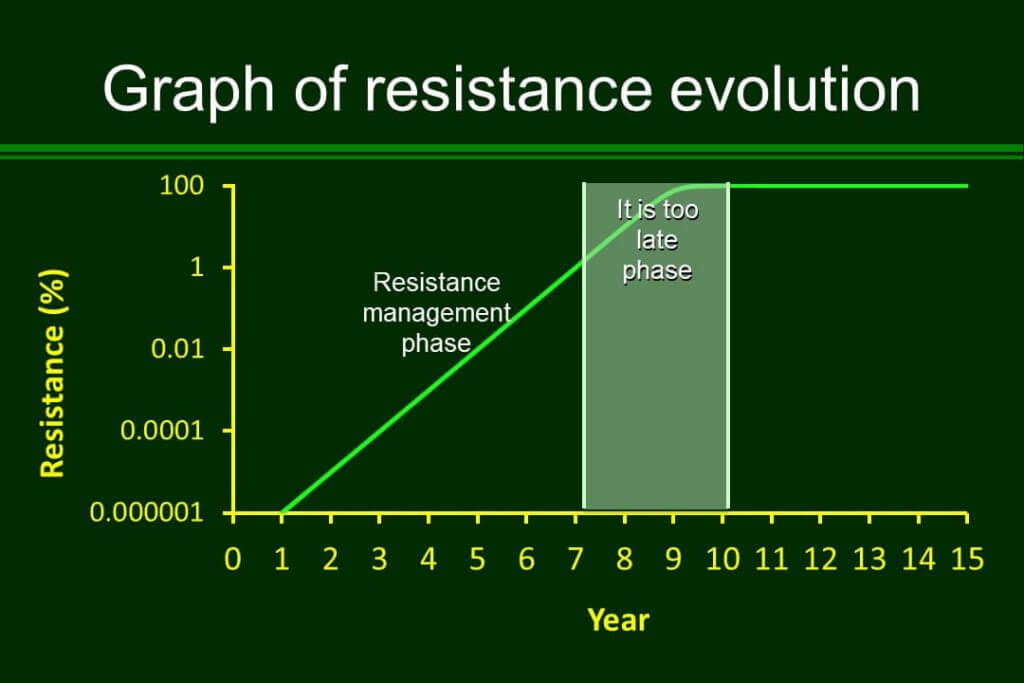Herbicide Control
Extensive information exists about herbicide options for herbicide intensive weed control. Many state extension programs publish current recommendations for effective control and are an excellent source of unbiased information. This page is designed to discuss the principles behind herbicide selection and to be complementary to state recommendations.
Use Multiple, Effective Sites of Action to Decrease Herbicide Resistance Development
Growers have relied on herbicides as the main tool for managing weeds in grain crops, preventing weeds from reducing yields and interfering with crop management and harvest. Reliance on the same or similar herbicides has resulted in weed biotypes evolving resistance to herbicides. Herbicide-resistant weed biotypes are no longer controlled by herbicides that previously killed them. New strategies are necessary to control these resistant biotypes. It is important to prevent herbicide-resistant weed biotypes from developing in the first place.
Reducing the risk of developing herbicide-resistant biotypes requires an integrated approach to weed control (IWM). Integrating prevention, mechanical, cultural, and biological as well as strategic chemical control is necessary to forestall herbicide resistance. When it comes to chemical weed control, farmers are hearing about rotating and diversifying herbicides, but the concept is often not explained.
Managing herbicide resistance requires an understanding of the herbicide site of action. Herbicide containers and labels now display a herbicide group number that identifies the site of action. While using different and multiple herbicide sites of action is important, understanding how to use “effective herbicide site of action” is critical for addressing herbicide resistance.
Read more on herbicide effective site of action and how to implement an effective herbicide program
1st video: Effective Site of Action and How it Should Be Used.
2nd video: “Should I Rotate Herbicides or Tank Mix Them?”
Research from past few years has shed light on how important it is to tank-mix herbicides compared to rotating herbicides.
In this video, Dr. Patrick Tranel explains his farm-based survey of over 100 Illinois farmers who tank-mixed herbicides compared to using them in sequence. This video explains why tank mixing herbicides is the best option to practice and encourages farmers and professionals to select at least two “Effective Site of Action Herbicides” as a consistent strategy for weed resistance management.
3rd video: A Deep-Dive into Tank Mixing Herbicides Compared to Rotating Them
Dr. Tranel explains why tank mixing is a more effective approach to resistance management than sequential applications.
Assuming resistance is already in the field, even when not detected due to low levels (year 1 to 7 on the graph), farmers should manage resistance while still being in the “Resistance management” phase (graph#1). In this phase, herbicide resistance frequency is lower than 1% and often is not visible in the field.
At that stage, we can still manage the frequency of resistance and prevent these weeds from becoming problematic. Without resistance management tactics, the frequency of resistance can increase rapidly. This is when weeds will become very noticeable in the field and it will be difficult to manage the now resistant weed population (“Too late“ phase in Graph#1).
Graph#1: Resistance evolution
Herbicide management appears to be the most important factor contributing to weed resistance.
Questions such as “does management affect resistance or does resistance influence management?” are covered in this video to help farmers understand what they can do to prevent this problem.

Slide Credit: Patrick Tranel, University of Illinois
For more information on chemical control click on the button below:
Authors
- Mark VanGessel
- Claudio Rubione
Contributors
- Victoria Ackroyd
- Michael Flessner
- Bob Hartzler
- Patrick Tranel
- Steven Mirsky